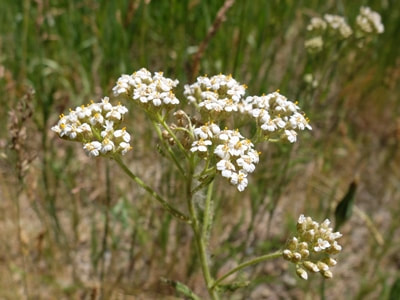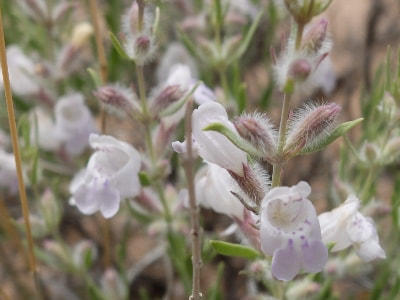|
Found in dry meadows and woods
Seen blooming in August near Hwy 554 in Abiquiu Yarrow grows one to two feet tall with feathery, fern-like leaves which have a strong, distinctive, not unpleasant smell. Small flowers grow in flat-topped clusters, most commonly white, less commonly pink. It is a popular cultivar and can be yellow, red and orange. The dried flowers are long-lasting and are often gathered for floral arrangements. Yarrow spreads from stout roots producing large patches of the fern-like leaves without flowers. It blooms all summer. The scientific name comes from the Greek character Achilles who is believed to have discovered the medicinal uses of this plant for healing his soldier’s wounds in the battle of Troy. Traditionally, Native Americans considered it a "life medicine" and used the plant as an analgesic and head cold remedy, for healing cuts and abrasions, relief from earaches, toothaches and throat infections, as well as for an eyewash. Source. If you are trying to identify a different flower then you can check what other flowers bloom this month. If you cannot identify a flower from the website, send a photo and where you took it to [email protected]. Read online for tips.
0 Comments
Found in sand, on arroyo edges Seen blooming in August on the Madera Trail, Santa Fe NF Frosted Mint is a sprawling, greyish, aromatic shrub growing one to three feet high and three feet across covered in fine, white hairs. The leaves are small and narrow. Tiny, two-lipped flowers grow in whorls at the base of the upper leaves forming long clusters. Flowers are pale lavender with purple spots on the lower lip. I have seen these plants in bloom from June to August. Depending on the time of year, the plant will smell more like rosemary, mint, or a combination of the two. Traditionally, the leaves were eaten raw, cooked or dried and used as a flavoring in seed mushes and other dishes. The plant has been used externally in the treatment of sores, rheumatism and ear problems. The leaves have been used to sweeten the flavor of other medicinal herbs whilst increasing their potency. Source. If you are trying to identify a different flower then you can check what other flowers bloom this month. If you cannot identify a flower from the website, send a photo and where you took it to [email protected]. Read online for tips. Alkali Buttercup, Seaside Crowfoot, Marsh Buttercup,Ranunculus cymbalaria,Buttercup (Ranunculaceae)8/7/2023 Found in wet areas, bogs, stream sides
Seen blooming in August by the Rio Chama Buttercups are usually found in moist environments so we don’t see too many of them in our dry, high desert. The Alkali Buttercup is fairly common in the right environment, which is muddy and often saline. It grows to less than 12 inches high with erect flowering stems and runners that take root and create colonies. Its glossy green leaves are mostly roundish, less than one inch wide, with scalloped edges and stalks up to three inches long. Flowers are small, less than 1/2 inch wide, with five petals. What appears to be more petals are yellow sepals, another feature of buttercups. A green, oblong seed head rises to 1/2 inch from the center of the flower. Traditionally, various Navaho groups used the Alkali Buttercup as a venereal aid, an emetic, and a ceremonial medicine. The Kawaiisu used it as a dermatological aid. Source. If you are trying to identify a different flower then you can check what other flowers bloom this month. If you cannot identify a flower from the website, send a photo and where you took it to [email protected]. Read online for tips. Found in rocky flats and canyons among grasses, scrub, and junipers
Seen blooming in August in Plaza Blanca Beardlip Penstemon has spikes of tubular flowers which are very attractive to hummingbirds. It grows to four feet tall with long, narrow, dark green leaves, mostly at the base of the plant. The flowers are 1½ inches long and have two long protruding upper lobes and three lower lobes with golden hairs in the throat. It blooms for many weeks. Native Americans had many medicinal uses for the plant. It was used for menstrual pain and stomachache, burns, coughs, gun wounds and arrow wounds, and as a diuretic. The chewed root was rubbed over the rabbit stick to ensure success in the hunt. A rabbit stick which was treated in this manner was sure to kill any rabbit that it was aimed at, provided the thrower had a good heart. Source. If you are trying to identify a different flower then you can check what other flowers bloom this month. If you cannot identify a flower from the website, send a photo and where you took it to [email protected]. Read online for tips. |
AuthorI am Marilyn Phillips, a native of England, whose love of nature and the outdoors from childhood brought me by a circuitous route to Crested Butte, Colorado in 1993 and 16 years later to northern New Mexico. My exploration of the many trails in these areas, my interest in wildflowers and photography, and career in computer system design came together in this creation. If you have any corrections, comments or questions, please contact me by email. Archives
September 2025
Categoriescopyright © 2020
|






 RSS Feed
RSS Feed